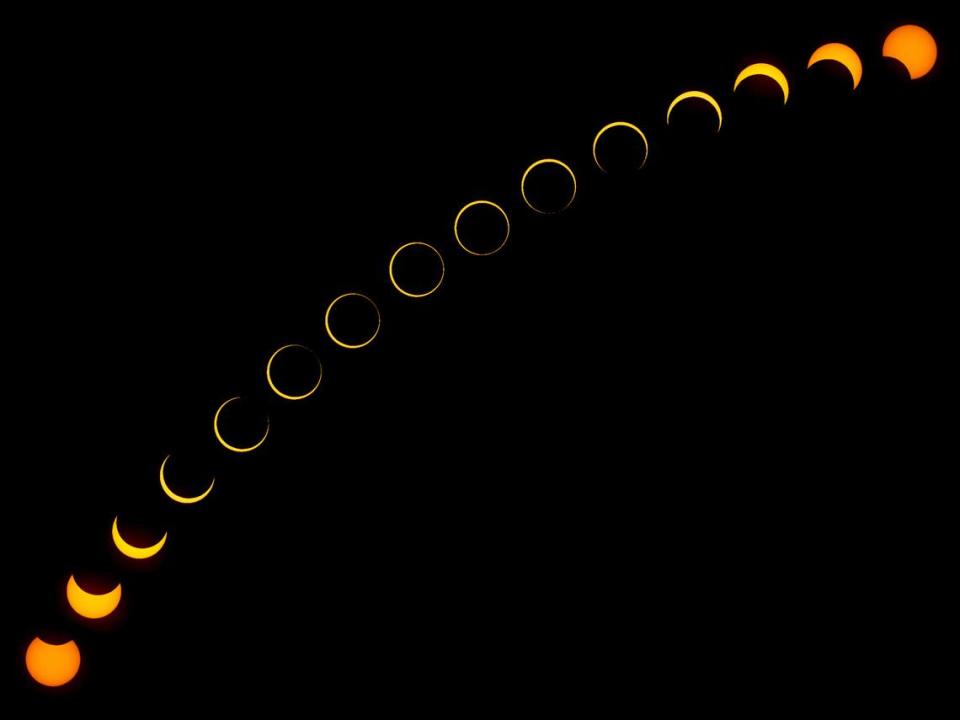Will Dallas-Fort Worth skies clear up for solar eclipse? Weather history offers a clue
We know a total solar eclipse will occur on April 8, but will we see the event with clear skies?
The path of totality begins in Mexico and runs northeast — across the United States — into Canada. Many on the northern reaches of the path of the eclipse may not be so lucky as far as the weather goes, which is why millions may saunter south to Texas hoping for a better viewpoint.
“In 2017 (total solar eclipse), there were 12 million people within the Path of Totality,” said Jo Trizila, founder of Total Eclipse DFW, an approved Eclipse Viewer Reseller by the American Astronomical Society. “In 2024, this number will more than double to over 32 million.”
[ The 4 best Texas cities to watch April’s total solar eclipse? You won’t have to drive far. ]
⚡ More trending stories:
→Want to make $275,000 a year and work from home?
→Is COVID variant JN.1 too smart for home test kits? What science says.
→Here's why your 2024 tax refund may be delayed.
The reason millions are expected to travel south — and many will travel to Texas — is for the prospect of the best weather to watch the celestial event. A quick look at historical weather data for the Dallas-Fort Worth region shows that the area recorded 30 days with at least measurable rain in 126 years (the period of record runs from 1897 to 2023). Austin, in 130 years, recorded rainfall in only 25 days (the period of record runs from 1893 to 2023).
If rain means clouds, then North Texas and the Hill Country are favorable places to view the solar eclipse. But how comfortable will the day’s temperature be? Dallas-Fort Worth’s lowest high temp for the day was 39 degrees in 1938, and Austin’s lowest high temperature is 44 degrees also in 1938.

Dallas-Fort Worth has front row seats to rare total solar eclipse
The Dallas-Fort Worth area will catch the total solar eclipse at 1:40 p.m. for 2 minutes and 33 seconds. Parts of the state that fall deep in the path of totality, such as Kerrville, will experience totality for 4 minutes 24 seconds. Weather will be fair for most of Texas, according to the Farmer’s Almanac.
It will be the first total solar eclipse visible in Dallas-Fort Worth since 1878 and the last for almost 300 years. The next total solar eclipse visible in North America will occur on Aug. 23, 2044.
Residents looking to spectate safely will need specialized glasses to watch the eclipse. According to NASA the specialized sunglasses needed must comply with the ISO 12312-2 international safety standard otherwise spectators risk eye damage.
“So in 2017, my daughter who went to Richardson elementary school, they had spent weeks and weeks and weeks studying about the total eclipse that was happening and they were so excited,” said Trizila, “The day of the eclipse they discovered that the glasses were not [meet] ISO [standards]... they weren’t safe and the kids could not watch the eclipse.”
Trizila does not want a repeat of her daughter’s disappointing experience. Not if she can help guide people to the proper equipment.

Weather outlook for select cities on the path of total solar eclipse
Places within a 125-mile-wide path of the event will experience totality. Here’s the Farmer’s Almanac regional forecast for select cities.
City, time of event, duration of totality, weather outlook
Austin — 1:36 p.m.; 1 minute, 53 seconds; fair weather for much of Texas
Little Rock, Arkansas — 1:51 p.m.; 2 minutes, 33 seconds; clouds may be problematic
Cape Girardeau, Missouri — 1:58 p.m.; 4 minutes, 6 seconds; generally dry and cool with scattered clouds
Carbondale, Illinois — 1:59 p.m.; 4 minutes 8 seconds; eclipse-watchers in Illinois should get good views, but Indiana, Kentucky and Ohio may not. Showers, thunderstorms increase from Ohio Valley, points east.
Indianapolis, Indiana — 3:06 p.m.; 3 minutes, 46 seconds; showers, thunderstorms increase from Ohio Valley, points east
Cleveland, Ohio — 3:13 p.m.; 3 minutes, 50 seconds; showers, thunderstorms increase from Ohio Valley, points east
Erie, Pennsylvania — 3:16 p.m.; 3 minutes, 43 seconds; clouds are likely to eclipse the eclipse for Pennsylvania, New York, Vermont, New Hampshire, Maine. Showers, thunderstorms possible.
Buffalo, New York — 3:18 p.m.; 3 minutes, 45 seconds; clouds are likely to eclipse the eclipse for Pennsylvania, New York, Vermont, New Hampshire, Maine. Showers, thunderstorms possible.
Hamilton, Ontario — 3:18 p.m.; 1 minute, 45 seconds; eclipse-watchers may not be fortunate with showers and thunderstorms increasing as it sweeps east.
Burlington, Vermont — 3:26 p.m.; 3 minutes, 14 seconds; clouds are likely to eclipse the eclipse for Pennsylvania, New York, Vermont, New Hampshire, Maine. Showers, thunderstorms possible.
Montreal, Quebec — 3:26 p.m.; 1 minute, 12 seconds; clouds are likely to eclipse the eclipse for Montreal and the Maritimes. Showers and thunderstorms are an increasing threat.
Island Falls, Maine — 3:31 p.m.; 3 minutes, 20 seconds; clouds are likely to eclipse the eclipse for Pennsylvania, New York, Vermont, New Hampshire, Maine. Showers, thunderstorms possible.
Fredericton, New Brunswick — 4:33 p.m.; 2 minutes, 16 seconds; clouds are likely to eclipse the eclipse for Montreal and the Maritimes. Showers and thunderstorms are an increasing threat.
Tignish, Prince Edward Island — 4:35 p.m.; 3 minutes, 13 seconds; clouds are likely to eclipse the eclipse for Montreal and the Maritimes. Showers and thunderstorms are an increasing threat.
Bonavista, Newfoundland — 5:13 p.m.; 2 minutes, 51 seconds; widespread clouds will probably obscure views of the solar eclipse for Newfoundland. Rain and wet snow.


